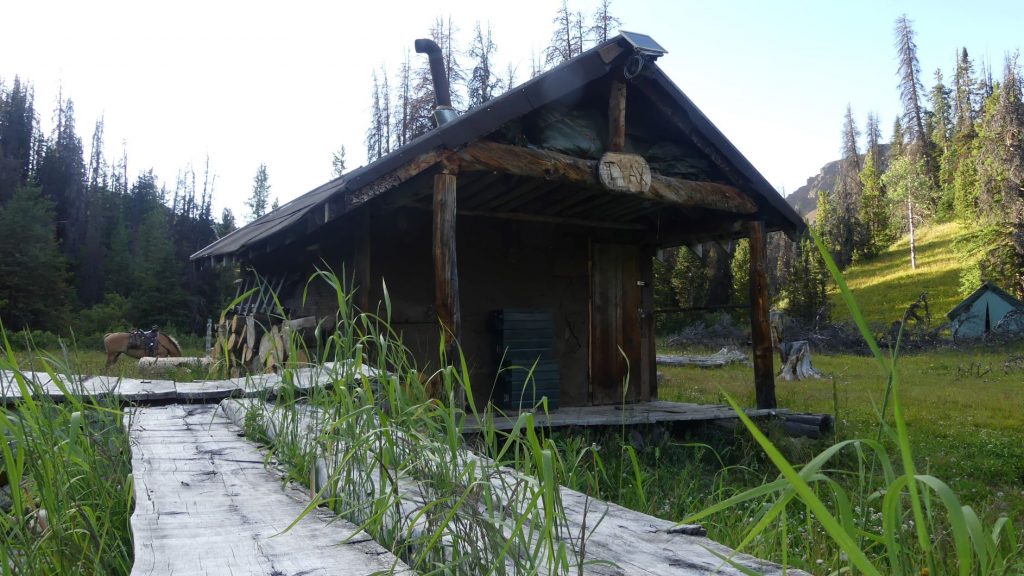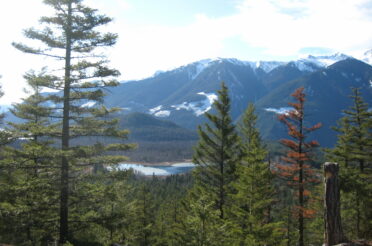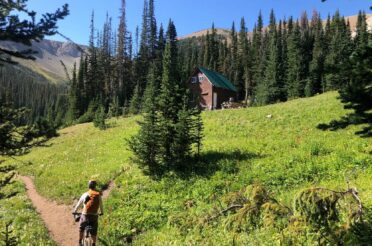Tyax Camp

Summary: Tyax Camp is on of our most remote camps, good for experienced riders or hikers. This story will provide you with more information about this camp, the wildlife and landscapes as well as how you can experience each of our Three Pillars, Nature Connection, Conservation and Stewardship and Personal Development while you are there.
You have to get up early to get to Tyax Camp, one of our twenty-five wilderness cabins where the energy of the mountains is felt most strongly. If you’ve got the time, you could ride in over two days, riding the Gun Creek Trail up to Spruce Lake, over-nighting here and then riding onto Tyax over Deer Pass. But usually we take the quick route. The Paradise Trail Head is a great way to turn a day’s ride into a ninety minute truck ride. If you’ve got 4WD and are prepared for the bouncy washboard, the cows on the road and the blind corners, you’re ready to experience the back-country roads of the South Chilcotin.
As I said, you’ll want to start early. You never know when a mudslide or boulder might impede your progress on the road. And once you’re at the trail head, it’s time to saddle up your horses and ride into camp. This is another six hours with a few sections where you’ll want to double check your route and weave around fallen trees that have blocked the trail.
Picture the scene: our group of ten – two mentor guides, two guests, four riding horses, one pack horse and a dog who thought she’d enjoy a ride in the truck but is now have doubts about the long hike into camp. We’re saddling up at the trail head. I’m one of the guides and with my trusty mare, Tatla, I’m going to lead the ride. Manon is my fellow mentor guide and she’s riding Castle, a bay horse who could be Tatla’s big brother. Our guests, Sharon and Steve are experienced riders, hikers and campers but this is the furthest they’ve ever been into the wilderness. That’s why we’re riding with them. Their horses are Fortress and Pearson, two calm, stable and reliable horses. Apache is our pack horse. He’s a little less experienced but he’s a good pack horse. The dog’s name is Sophie and as she takes a nap and refuses to get out the truck, I’m wondering if I should have brought the cat, Tosh, instead. At least he’d have slept in my backpack the whole way and would have caught mice around the cabin.
But once we hit the trail, Sophie comes to life, leading the way, darting off after squirrels, following along behind Castle at the back of the group. Every time she freezes under a tree and looks up, our attention is drawn – what has she seen? Can we be as excited about being out in the wilderness as she is?
The ride into camp is stunning. Although the ride starts off in forest, crossing creeks of all sizes, soon we are skirting the edges of mountains and riding over sandy slopes, high above tree line. To our left and behind us is Castle Peak. This distinctive pyramid structure is the vent of an old volcano. Long ago, this area was a volcano which is why the grass is so fertile here now: wildflowers bloom in the meadows, trees make dense forests, x`grass grows in a variety of shades.
As we get up on the sandy slopes, we can see Mount Relay to our right. To our left on what we affectionately call the Goat Rock, a huge rocky projection standing up in the sand and shale, are five mountain goats, three nannies and two kids. Sharon and Steve take photos, this is the first time they’ve seen mountain goats. It’s also the furthest they’ve ever been into the wilderness on horseback. They are in awe of all the different colours of the mountains around them. We are skirting Mount Cunningham, a mountain with a big white rock face, not that we can see it as we make our first descent. Into the valley we walk, jumping off our horses and zig-zagging down to take the pressure off the horses’ shoulders.
At the bottom of the valley, we climb back on our horses and begin our ascent again. We’re riding through more meadows and forest, startling a doe and her fawn who were resting to the left of us. They jump up and bound away, stopping when they feel they’re at a safe distance. We ride through the last meadow, descending again. The trail weaves its way into camp. I know the moment Sharon and Steve catch a glimpse of the cabin. They both suck in their breath excitedly. We made it. Here’s our home for the next week.
Once we’ve unpacked the horses, our next task is to stake them in the meadows around camp. We ride out, stake the horses, teaching Sharon and Steve how to hammer in the stakes with a splitting maul and tie the knots, then we walk back. Sophie is ready for a nap, stretching out on the cabin porch. It’s a small cabin but filled with everything you need – a propane stove, a wood burner, cooking equipment and upstairs sleeping loft for when it’s too cold to sleep in the canvas wall tents.
We give Steve and Sharon a tour of the campground, the outhouse under a tarp tepee, the saddle rack where the horses’ oats are stored then make our first foray into the cabin. The door sticks a little, letting us know we’re in the wilderness. The nails under the windows also let us know that – they’re a bear deterrent. From your first impression, you might think there’s no running water here. But don’t be fooled by a city definition of “running water”, Tyaughton Creek runs just 100 yards from the cabin, we have running water constantly flowing past.
Although we have the propane stove, we all agree we want to cook over the campfire. So we make a fire in the fire pit to cook and eat outside. Tonight’s dinner is lasagne and garlic bread with rhubarb crisp for dessert, we’ve been anticipating it all day. We make sticks from willow branches to roast marshmallows over the fire. Of course, they get burned but that’s part of the experience. As we eat, we reflect on the day, every challenge and success, the journey to camp, Sharon and Steve share their first time experiences, how they’ve bonded with their horses, checking they remember the names of all the wildflowers they’ve learned. Being in the wilderness these reflections that people (particularly adults) might normally feel self-conscious about, flow naturally, they’re such important experiences we just want to share them.
The two canvas wall tents are the perfect accommodation after a day in the saddle. Soft foamie pads, our sleeping bags and a pillow made out of a spare jacket are all we need to fall asleep in seconds.
Sleeping in a tent means we’re all four up at first light to bring our horses in and start riding. After a breakfast of fried eggs, sausages and toast, this time cooked on the wood burner in the cabin, we’re off to explore the area. Yesterday was a big day, so today we take it a little easier and ride to Deer Pass. As we sit astride our horses, looking over to the next mountain range, the Leckie Range, and Warner Lake and back at where we’ve come – Sharon and Steve not quite believing their horses crossed that steep shale slope – the wind whips around us, lashing the horses tails against our backs and making us all hold onto our hats, we feel infinitely alive and refreshed. Manon and I point out the way to Spruce Lake and the ranch, showing the way we could have ridden in.
The rest of the week is made up of day rides with the theme of connecting to nature. Sharon and Steve fully embrace this, we follow grizzly tracks along the trail. We know it was a grizzly not a black bear that made them because the toes and paw pads form a line and the claw marks are visible. Black bears have more rounded feet. They learn the names of more wildflowers. We spot a herd of California Bighorn sheep through our binoculars grazing the mountain side. Sharon and Steve attempt to fish for trout in the creek. They don’t catch anything but have a good time.
One day, we ride to Elbow Pass. This marks the boundary between the South Chilcotin Provincial Park where Tyax Camp is and the Big Creek Provincial Park. Another day we ride all the way to Lorna Lake where Steve and Sharon marvel at the blue-green glacial water – but none of us are brave enough to go for a swim, not even Sophie. Lizard Pond is another excursion, the water here is a darker blue and the mountains surrounding us are spectacular.
The horses are our wilderness facilitators, turning their ears, heads or whole bodies to point out to us wildlife we would otherwise have ridden straight past. They know exactly where to put their feet to carry us safely along the trail. Sharon and Steve are impressed by their horses’ sure-footedness, calm attitude and the way they pick up the pace when they know they’re going back to camp. They feel closer to nature now from learning about the mountains, taking a nap in a meadow of wildflowers and playing their part for conservation as they fill in our wildlife sightings forms with us.
But mostly what they talk about is the sense of peace in nature, the solitude of this area, further off the beaten track than many of our camps. We didn’t see another person all week, but we saw plenty of wildlife. The quiet made them reflect on their experience and themselves. We rode back to the trail head with Steve and Sharon feeling a huge connection to this land that they had spent a week travelling through. And Manon and I felt that sense of connection too. No matter how many times we ride these mountains, there’s always something new to learn, a deeper connection to be made.
You have to get up early to get to Tyax Camp, one of our twenty-five wilderness cabins where the energy of the mountains is felt most strongly. If you’ve got the time, you could ride in over two days, riding the Gun Creek Trail up to Spruce Lake, over-nighting here and then riding onto Tyax over Deer Pass. But usually we take the quick route. The Paradise Trail Head is a great way to turn a day’s ride into a ninety minute truck ride. If you’ve got 4WD and are prepared for the bouncy washboard, the cows on the road and the blind corners, you’re ready to experience the back-country roads of the South Chilcotin.
As I said, you’ll want to start early. You never know when a mudslide or boulder might impede your progress on the road. And once you’re at the trail head, it’s time to saddle up your horses and ride into camp. This is another six hours with a few sections where you’ll want to double check your route and weave around fallen trees that have blocked the trail.
Picture the scene: our group of ten – two mentor guides, two guests, four riding horses, one pack horse and a dog who thought she’d enjoy a ride in the truck but is now have doubts about the long hike into camp. We’re saddling up at the trail head. I’m one of the guides and with my trusty mare, Tatla, I’m going to lead the ride. Manon is my fellow mentor guide and she’s riding Castle, a bay horse who could be Tatla’s big brother. Our guests, Sharon and Steve are experienced riders, hikers and campers but this is the furthest they’ve ever been into the wilderness. That’s why we’re riding with them. Their horses are Fortress and Pearson, two calm, stable and reliable horses. Apache is our pack horse. He’s a little less experienced but he’s a good pack horse. The dog’s name is Sophie and as she takes a nap and refuses to get out the truck, I’m wondering if I should have brought the cat, Tosh, instead. At least he’d have slept in my backpack the whole way and would have caught mice around the cabin.
But once we hit the trail, Sophie comes to life, leading the way, darting off after squirrels, following along behind Castle at the back of the group. Every time she freezes under a tree and looks up, our attention is drawn – what has she seen? Can we be as excited about being out in the wilderness as she is?
The ride into camp is stunning. Although the ride starts off in forest, crossing creeks of all sizes, soon we are skirting the edges of mountains and riding over sandy slopes, high above tree line. To our left and behind us is Castle Peak. This distinctive pyramid structure is the vent of an old volcano. Long ago, this area was a volcano which is why the grass is so fertile here now: wildflowers bloom in the meadows, trees make dense forests, x`grass grows in a variety of shades.
As we get up on the sandy slopes, we can see Mount Relay to our right. To our left on what we affectionately call the Goat Rock, a huge rocky projection standing up in the sand and shale, are five mountain goats, three nannies and two kids. Sharon and Steve take photos, this is the first time they’ve seen mountain goats. It’s also the furthest they’ve ever been into the wilderness on horseback. They are in awe of all the different colours of the mountains around them. We are skirting Mount Cunningham, a mountain with a big white rock face, not that we can see it as we make our first descent. Into the valley we walk, jumping off our horses and zig-zagging down to take the pressure off the horses’ shoulders.
At the bottom of the valley, we climb back on our horses and begin our ascent again. We’re riding through more meadows and forest, startling a doe and her fawn who were resting to the left of us. They jump up and bound away, stopping when they feel they’re at a safe distance. We ride through the last meadow, descending again. The trail weaves its way into camp. I know the moment Sharon and Steve catch a glimpse of the cabin. They both suck in their breath excitedly. We made it. Here’s our home for the next week.
Once we’ve unpacked the horses, our next task is to stake them in the meadows around camp. We ride out, stake the horses, teaching Sharon and Steve how to hammer in the stakes with a splitting maul and tie the knots, then we walk back. Sophie is ready for a nap, stretching out on the cabin porch. It’s a small cabin but filled with everything you need – a propane stove, a wood burner, cooking equipment and upstairs sleeping loft for when it’s too cold to sleep in the canvas wall tents.
We give Steve and Sharon a tour of the campground, the outhouse under a tarp tepee, the saddle rack where the horses’ oats are stored then make our first foray into the cabin. The door sticks a little, letting us know we’re in the wilderness. The nails under the windows also let us know that – they’re a bear deterrent. From your first impression, you might think there’s no running water here. But don’t be fooled by a city definition of “running water”, Tyaughton Creek runs just 100 yards from the cabin, we have running water constantly flowing past.
Although we have the propane stove, we all agree we want to cook over the campfire. So we make a fire in the fire pit to cook and eat outside. Tonight’s dinner is lasagne and garlic bread with rhubarb crisp for dessert, we’ve been anticipating it all day. We make sticks from willow branches to roast marshmallows over the fire. Of course, they get burned but that’s part of the experience. As we eat, we reflect on the day, every challenge and success, the journey to camp, Sharon and Steve share their first time experiences, how they’ve bonded with their horses, checking they remember the names of all the wildflowers they’ve learned. Being in the wilderness these reflections that people (particularly adults) might normally feel self-conscious about, flow naturally, they’re such important experiences we just want to share them.
The two canvas wall tents are the perfect accommodation after a day in the saddle. Soft foamie pads, our sleeping bags and a pillow made out of a spare jacket are all we need to fall asleep in seconds.
Sleeping in a tent means we’re all four up at first light to bring our horses in and start riding. After a breakfast of fried eggs, sausages and toast, this time cooked on the wood burner in the cabin, we’re off to explore the area. Yesterday was a big day, so today we take it a little easier and ride to Deer Pass. As we sit astride our horses, looking over to the next mountain range, the Leckie Range, and Warner Lake and back at where we’ve come – Sharon and Steve not quite believing their horses crossed that steep shale slope – the wind whips around us, lashing the horses tails against our backs and making us all hold onto our hats, we feel infinitely alive and refreshed. Manon and I point out the way to Spruce Lake and the ranch, showing the way we could have ridden in.
The rest of the week is made up of day rides with the theme of connecting to nature. Sharon and Steve fully embrace this, we follow grizzly tracks along the trail. We know it was a grizzly not a black bear that made them because the toes and paw pads form a line and the claw marks are visible. Black bears have more rounded feet. They learn the names of more wildflowers. We spot a herd of California Bighorn sheep through our binoculars grazing the mountain side. Sharon and Steve attempt to fish for trout in the creek. They don’t catch anything but have a good time.
One day, we ride to Elbow Pass. This marks the boundary between the South Chilcotin Provincial Park where Tyax Camp is and the Big Creek Provincial Park. Another day we ride all the way to Lorna Lake where Steve and Sharon marvel at the blue-green glacial water – but none of us are brave enough to go for a swim, not even Sophie. Lizard Pond is another excursion, the water here is a darker blue and the mountains surrounding us are spectacular.
The horses are our wilderness facilitators, turning their ears, heads or whole bodies to point out to us wildlife we would otherwise have ridden straight past. They know exactly where to put their feet to carry us safely along the trail. Sharon and Steve are impressed by their horses’ sure-footedness, calm attitude and the way they pick up the pace when they know they’re going back to camp. They feel closer to nature now from learning about the mountains, taking a nap in a meadow of wildflowers and playing their part for conservation as they fill in our wildlife sightings forms with us.
But mostly what they talk about is the sense of peace in nature, the solitude of this area, further off the beaten track than many of our camps. We didn’t see another person all week, but we saw plenty of wildlife. The quiet made them reflect on their experience and themselves. We rode back to the trail head with Steve and Sharon feeling a huge connection to this land that they had spent a week travelling through. And Manon and I felt that sense of connection too. No matter how many times we ride these mountains, there’s always something new to learn, a deeper connection to be made.
Charlie



